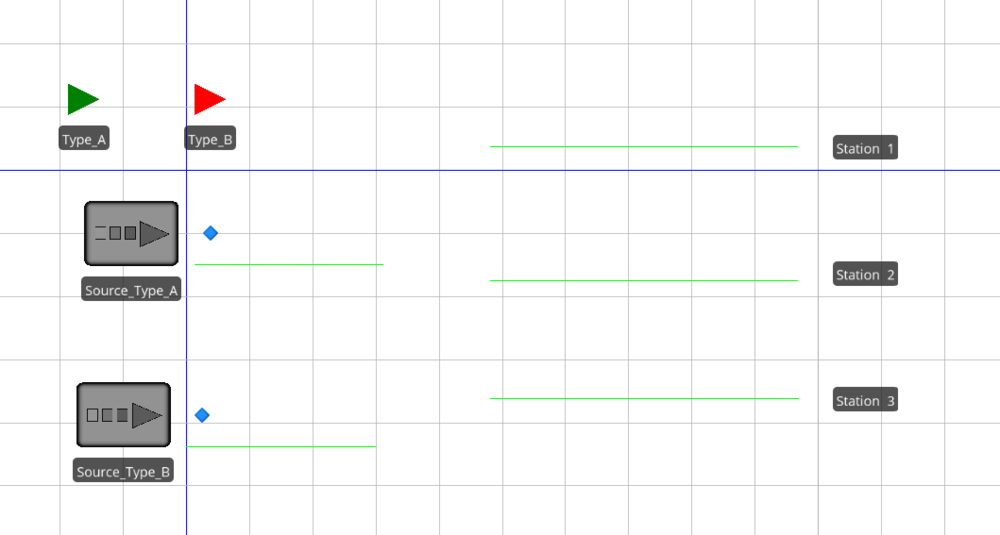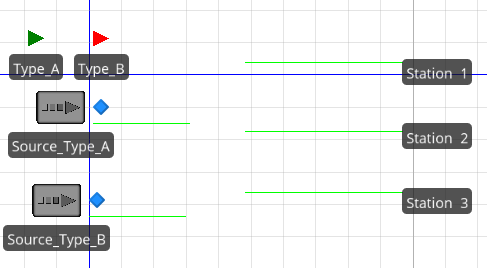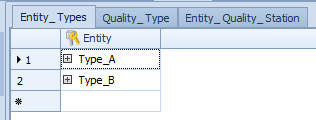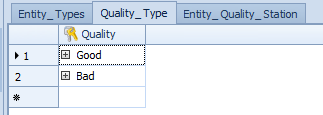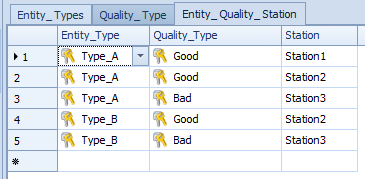Search the Community
Showing results for 'user defined statistics'.
-
Entity Distance travelled on Transporter
Liz Millar replied to ttarkan's topic in SI General Discussions
I would recommend using a Data Table. One column could have all your entity types defined. The next column could be a Tally Statistic Element Reference Property. This column would match up the Tally statistic you want to correspond with the Entity Type. You could choose to auto-create these Tally Statistics from the Data Table. If you change the Tally Statistic Property's column Reference Type property from 'Reference' to 'Create', this will make the Tally Statistics for you. I recommend the Help page "Table-Based Elements (Auto-Create)" in Simio for more information. If your Entity Instances noted in the Data Table are unique, no duplicates, you can set that column as a Key. With that column as a Key, you could use just the Tally step and use the RowForKey expression. RowForKey will allow a key input to search for in that column. If the model entity is driving the process, you could use an expression like this for the Tally Statistic Name 'Table1[Table1.EntityInstanceProperty1.RowForKey(ModelEntityReference)].TallyStatisticProperty'. Since it seems this process will be on the OnRunEnding, it will not have a reference to a specific entity, so you will most likely need a Search step to find the entities still in the system. I would set the Search step to find Infinite things and let each entity reference exit on the found branch. If the EntityInstanceProperty column in your Data Table has the Auto-set Table Row Reference property to 'True', the entities will already know the row reference and your Tally step Tally Statistic Name property could be 'Table1.TallyStatisticProperty'. -
Simio is pleased to announce the 1st Annual Simio User Group Meeting, scheduled for May 24-25, 2017, in Pittsburgh, PA. This meeting will be very interactive and informative for current or future users of Simio’s simulation and scheduling software. The meeting will be held at the Drury Plaza Hotel Pittsburgh Downtown, which is a brand new hotel built in the historic Federal Reserve Bank building. Who Can Attend? Anyone currently using Simio’s simulation and scheduling software for any industry is invited to attend. Alternatively, if your company is considering using Simio software, we invite you to attend, as well, to gather more information about the product and how it can help you. What to Expect This meeting will be jam-packed with great presentations, advanced learning seminars and outstanding networking opportunities with Simio users and employees. With your registration, you will also receive meals, a book including all of the papers presented at the meeting for both days, and a special Pittsburgh themed gift! There will be plenty of information to go around, so if you’ve invested in Simio, you won’t want to miss this event. You’ll be able to see real user experiences and get some great feedback on how to better utilize the software to generate even greater results. Information for Presenters If you currently use Simio software and would like to present a paper at the User Group Meeting, we’d love to hear from you. All the paper needs is the following information: A brief overview of your company Why you chose Simio The approach used in Simio Results achieved by using Simio Pricing Information A block of rooms are reserved. However, in order to receive the discounted rate to the hotel, you must book your room on or prior to April 20, 2017. The prices for the event itself are: Early Registration (before April 14, 2017) – $50 for attendees, $40 for presenters Open Registration (before May 12, 2017) – $60 for attendees Late Registration – $100 for attendees Note: All presenters must be registered by April 14, 2017. We encourage you to attend this event so you can learn more about Simio success stories. Be sure to sign up today to secure the early registration rate. https://www.simio.com/resources/events/2017-User-Group-Meeting/ Hope to see you there!
-
Conditional entity release one at a time
gocken replied to Amine3225's topic in SI General Discussions
Hi Amine, I have defined a new process named process1 which is triggered by Input@BUFFER_ST_1.Entered event. Then, I used interrupt step (in process 1) to get one entity from processing station whenever process 1 is triggered. Note that I set the processing time of BUFFER_ST_2 server to infinity to hold entitys until Input@BUFFER_ST_1.Entered event is occured. I am not sure if setting this to infinity is a problem?. Other than this everything is ok and it seems it works. Buffer varianti trazioni V2.spfx -
Hello, I'm new to both the forum and the world of simio in general. I am trying to simulate how much the maximum buffer could be in 2 points of my process which are defined by the Buffer_ST1 and Buffer_ST2 servers. My problem is that I would like the Buffer_ST2 server based on a condition that would be every time an entity passes on Input @ Buffer_ST1, the Buffer_ST2 server releases only one processed entity and not all those inside the server as it happens now, I hope for being clear and thank you in advance. I put the model in the attachment Buffer varianti trazioni V2.spfx
-
In the attached model, I want to transfer entities to stations depending on some criteria defined in a table. I have 2 types of entities, "A" and "B", defined in a table as primary keys. Also I have 2 states, "Good" or "Bad", also in a table as primary key. Finally I have 3 stations. I have a table that has 3 columns, “Entity_Type”, “Quality_Type” and “Station”. For example a row could be "A"; "Good"; "Station 1". It is possible for entity "A" with "Good" quality to end up in either "Station 1" or "Station 2", and in that case I want to randomly select one. The problem is that I cannot use a RandomRow based in more than one criteria. Either I use RandomRow for the rows of the table that are type "A" or quality "Good", but I am not finding a way to do more than one combination. This model is a simplification of the real model which is more complex and has hundreds of combinations. Model_RandomRow_FilteredTable.spfx
-
https://jobs.arup.com/jobs/aviation-analyst-9522 Arup is proud to be recognized by Fast Company in their third annual Best Workplaces for Innovators list, which honors businesses and organizations that demonstrate a deep commitment to encouraging innovation at all levels. We find solutions for some of the world’s most complex problems. From climate action to social value, we consider the broadest impacts of our work. We strive to build a more sustainable, resilient, and equitable future. This purpose shapes our culture and has made us leaders in sustainable development. You’d be joining our multi-disciplinary design teams focusing on technical excellence and innovative solutions that create a better future for people, places, and the planet. Start Here, Go Anywhere! Want to work for a company that invests in innovation and people who catalyze impact in the built environment? Arup is proud to be recognized by Fast Company in their third annual Best Workplaces for Innovators list, which honors businesses and organizations that demonstrate a deep commitment to encouraging innovation at all levels. We find solutions for some of the world’s most complex problems. From climate action to social value, we consider the broadest impacts of our work. We strive to build a more sustainable, resilient, and equitable future. This purpose shapes our culture and has made us leaders in sustainable development. You’d be joining our multi-disciplinary design teams focusing on technical excellence and innovative solutions that create a better future for people, places, and the planet. During your career at Arup, you’ll have the chance to engage in a fulfilling career and work with some of the most highly respected engineers and specialists in the world. You’ll also get the opportunity to work on exciting and significant projects, delivering quality work that has a positive and lasting influence on the community and the environment. Responsibilities of this specific role will include, but not be limited to the following: • Perform capacity/demand assessment for planning studies using various tools, methods and techniques • Conduct passenger and baggage flow simulation modelling, interpret results and identify solutions • Develop spatial requirements and program development for infrastructure and facilities planning • Undertake data driven analysis to gather insights including research-based projects • Assist with development of automation tools using programming languages • Assist with development and review of forecast demand • Collect and collate data from surveys, benchmark studies and other sources as needed in support of planning studies • Assist in preparation of reports, presentations and deliverables including illustrations, tables and drawings to communicate complex technical ideas through a graphical and visual approach for a wide range of clients • Generate and contribute to planning and operational reports and provide advice to planning and design teams, airports and airline clients • Project work includes many of the most significant complex airport developments globally • Some travel may be required in the longer term Qualifications Required: • Bachelor’s degree (Master’s degree preferred) in Civil/Industrial/Operations Research/Transport engineering or other relevant disciplines • 2-5 years of increasingly responsible experience in airport planning and analysis • Knowledge/experience of analytical techniques and tools applied in airport planning including spreadsheet, database and simulation software such as Simio, CAST or others • Python or R or similar programming skills preferred • Proficiency in Microsoft Office applications (Word and PowerPoint); advanced Excel user • Demonstrated strong numeric analytical competence and strategic thinking capability • Good written and verbal communication skills essential for team-based working • Excellent planning and organization skills and attention to detail for our fast-paced environment • Must be highly motivated, proactive and willing to take on new challenges Arup is the creative force at the heart of many of the world's most prominent projects across our industry. We offer a broad range of professional services to clients around the world that combine to make a real difference to our clients and the communities in which we work. Notable Projects: • Toronto Pearson International Airport • Montreal Trudeau International Airport • New York John F. Kennedy International Airport • Chicago O’Hare International Airport • Los Angeles International Airport • Istanbul International Airport • London Heathrow International Airport • Singapore Changi International Airport Benefits that Work - At Arup, we have a comprehensive and valuable benefits program that works for our employees and their families. These are 100% paid for by Arup expect for optional life insurance. These benefits provide health and welfare security for you as well as paid time off for rest and renewal. Our Global Profit Share Plan (paid bi-annually) provides an opportunity for you to share in the success of the Firm. As a valued employee of Arup, you can also choose to participate in our GRRSP 5% company match to help you save for your future. COVID-19 Vaccination Requirement - Arup requires all new employees to be vaccinated for COVID-19. Arup is an equal opportunity employer and consistent with federal, state, and local requirements, will consider requests for reasonable accommodation based on disability or sincerely held religious beliefs where it is able to do so without undue hardship to Arup. Flexible Working - We believe that flexible arrangements create a more inclusive way of working that supports our diversity and the wellbeing of our people. Options for alternative schedules and the ability to work outside of the office for a portion of your workweek are available. Arup is an Equal Opportunity Employer. We consider all qualified candidates regardless of national origin, veteran, disability, sixual orientation, gender, gender identity or other status protected by law. If you need any assistance or accommodations due to a disability, please contact us at americasbenefits@arup.com. For the fourth consecutive year, Arup has been named one of Greater Toronto’s top employers! Greater Toronto’s Top Employers for 2021 are recognized for exceptional human resources programs and forward-thinking workplace policies. Find out more about what makes our Toronto office an outstanding place to work here: https://bit.ly/2B3QYL8
-
The answer is no! If you call MATLAB via user generated MATLAB step simio will temporarily suspend till the outgoing token will return (with a value or not). If you add a breakpoint, simio will come to a "full stop". This means simio can not send any token to run/call matlab/codes. Most likely your problem is that the matlab user defined step does not work properly. If it works properly you need not to stop simio anyway. Try to locate the required files appropriately or check your visual studio edition etc.? I am not sure what is the problem but the .dll file can be outdated?
-
This post contains additional files associated with the paper "Agent-base modeling and simulation in Simio" by Thomas Kehl. The additional files include the original paper, an installer for the Simio Agent Library, the Simio Agent Library user extension, and further documentation. These files were created by Thomas Kehl and are not endorsed or supported by Simio LLC. Note also that these files were published with the paper in 2018 and might be out of date. 1585821475_SimioAgentBasedModeling-ThomasKehl.zip
- 1 reply
-
- 2
-

-

-
- api
- user add-in
-
(and 2 more)
Tagged with:
-

Process Logic Design for Data-Generated Models
asneath replied to oalotaik's topic in SI General Discussions
Process logic is typically added to a model on an as needed basis. For instance you will notice that some of our Scheduling examples, like SchedulingDiscretePartProduction (via Support ribbon -> Examples) does not use any process logic. There are several ways to initiate process logic which you could read more about in the "Processes" help topic. For instance, all objects in the Standard Library have an Add-On Process Triggers property category that allows you to specify specific points in the simulation that you would like to execute a process (like on Entered for a Server). A quick tip: you may double click an Add-On Process Trigger property (like Entered for a Server) to create a new process corresponding to that trigger. There are also other ways to initiate processes: using Elements like Timer or Monitor, user-defined Events, or the Execute step. I would recommend investigating these further in the help documentation if you are interested in learning more. One of our newest example models (provided in the software) called InfectiousDiseaseSampleModel demonstrates using fairly comprehensive process logic along with a data-driven approach. Happy modeling! -
I have a situation where I have entities at a single source that are transferred to their destination by a vehicle. Each vehicle delivers 1 entity per trip. The destination is dictated by the entity's state variable ModelEntity.DropOff (if=1, then drop off at server 1, if=2, drop off at server 2, etc..). The vehicle path is the same for all vehicles (pick-up, then server 1, then server 2, etc.... return home) until they drop off their entity. Once they drop off their entity, they immediately return home to pick up another entity. With support's help, I have the model working fine except for the drop-off part (right now vehicles pick-up an entity, follow a nodelist, and dropoff entities at random destinations in the nodelist, and return home to pick up another) . I cannot figure out how to tell a vehicle to drop off a particular entity at a particular destination based on the attributes of the riding entity. Any help would be appreciated. Thanks, Scott
-
Hi, I have implemeted a SimBit Leveled Arrivals, when I have entities arriving in a certain order. I also have additional features defined in the data table, which contains the order of entities (numeric definitions). I would like to have statistics on each entity of this table. I tried to introduce an integer column, and modify it as a reference property within State Assignments group, but I failed. To make it easy. In the datatable I have a certain material of certain amount. Depending on these numbers, I would like to count, how many products I will receive from each material. Is it possible to have this within this very single table?
-
Did you look around "start tasks" step in processes tab? You can use this in processes together with a user-defined "task sequence" element (definitions-->elements).
-

Avg Waiting Time Tally Values don't seem right
dsturrock replied to wwang7f's topic in SI General Discussions
Your user-defined Tallies were not generating accurate results because you did not specify units of time on the statistic definition. I did not do a thorough review, but what I checked seemed reasonable to me. The waiting time should be the sum of processing time + freespace travel time + waiting for server/resource time. The 2 experiments you had both illustrated constrained resources with lots of waiting time. When I added a 3rd scenario with high resource capacities (99 each) the TIS statistics were in the range I would expect. -
Hello everybody, Is there any way to collect state statistics for each candidate from population of i.e. vehicles without sub-classing this object? I have i.e. v1ehicle with a population of 8, I want to have the number of movements for each of this 8 forklifts. Can I do it without subclassing vehicle object or making 8 seperate state statistics elements? Thanks in advance.
-
Hi I have created an object and need now a property of type table for this object. The tables which can set for this property should have a defined schema (two columns, the first of type datetime and the second of type real). My question is: Is it possible to pretend the Definition of the Schema for the tables, which can be assigned to my property? Thanks for your help. Thomas
-

Planned Maintenance and different course for entities
asneath replied to AInemarieb's topic in SI General Discussions
Simio offers user-defined work schedules in the Data tab. The SimBit ServerFollowsCapacitySchedule or others related to work schedules could be helpful. You can define a Pattern Based Work Schedule, to account for the shifts you described, and modify Server Properties like OffShiftRule (under Secondary Resources) to 'Finish Work Already Started' or 'Suspend Processing' depending on what makes sense for your Model. Adam -
I have a series of gated processes that are defined in a sequence table. Occasionally sequential gates will use the same server. In our process, the entity doesn't actually move out of the server, but in Simio the entity has to exit the server and re-enter. What winds up happening is that if another entity is queuing for that server, it will enter first during the approximately 2 seconds it takes for the entity to travel from the output node to the input node , causing the entity that was in the server to queue. I would like the entity to stay in the server through multiple gates, according to the routing logic, without getting bumped by other entities in the queue. It's important to keep the gates separated instead of combining them into a single entry on the routing table, because I need to look at performance statistics for each gate separately. Thank you
-
I have a worker and I want to know utilization of whole population. I would like to have something like Worker.Resourcestate(1) Worker[1].ResourceState(1) gives results for Worker[1] only. Is there any easy way how to do this? Thanks
-
My name is Breno Souza and I have already done some questions on Simio User Facebook group about my model. I am working in the Automation Strategies Laboratory of the Computing Department of Federal University of São Carlos. As computer engineering students, we have to model more complex models in order to validate our researchs, using some dispatching rules for Automated Guided Vehicles using Genetic Algorithms, and we also use complex algorithm systems to the production scheduling using some ERPs integrated with the simulation model. The suggested solution, by Mr. Sturrock, on the Facebook group, using decision nodes for each part type in each process production, means limiting our model, decreasing the flexibility of our factory and our programming possibilities, since that we cannot specify complex rules both for dispatching and routing. We are mainly concerned about specifying manufacturing production sequences using programming, due our complex and several routing rules. We would like to know if is possible to control the simulation, mainly specifying routings, using some programme language. We have used Automod some years ago, and it was possible to specify alternative routings and some control logics using C++ programming. Is that possible in SIMIO? Are there examples on that? How can we integrate our model with some ERP or SCADA system? Would be possible doing that using some factory floor protocol, such as OPC? My past doubts (posted on Simio Users Facebook group) are attached. Yours faithfully, Breno de Oliveira Souza Computer Engineering Undergraduate Student Researcher at Automation Strategies Laboratory Federal University of São Carlos ---------------------------------------------------------- Hello everyone, I'm a new SIMIO user and I have a problem on my model. Let me give a brief explanation about my model. I am modeling a Flexible Manufacturing System, where different parts are produced by different machines. I have many different entities (parttypes) that follow each one a different process sequence. Each part type pass through about 10 process. I have already seen examples where the sequence is modeled by using the sequence tables. However, my problem is due, for each process, a entity could be processed by different machines. For example, the part type A has the following sequence: M1 OR M2 -> M3 OR M4 -> M5 OR M6 OR M7 and so on.. I'd like to know how I can put this "OR" im my model... I don't think I can use the sequence tables, since that I am not able to use expressions on that. I really would appreciate if u could help me. If I wasnt understandable, pls let me know. Thank you very much for your attention. -------------------------------------------------------------
-
Hi Jim, May be there are many possible ways to follow to get the information you want. But, I suggest you to use a search step for searching a server's (or any other object's) processing queue to get such information. You can search not only the server's processing queue but also the whole "entity population" to get whole state variable's defined on them at any arbitrary time thoughout the simulation run. All you have to do is to define additional expressions on search step. In the example file attached a simple model is developed to get entities' state variables residing at server1's processing queue. Here note that, you have to click button at arbitrary times. Then, if 3 or more entities exist at server1.processing queue, the search step founds the first 3 of them (since a forward search is performedin this sample model) then later an excel write step writes entities created time (you can get many state variables of entities written on the same excel file). You can change search limit, queue state name, include a match condition etc. If you want to get such information at the beginning or at the end of the simulation run you should use this same logic at appropriate processes (onrunending, onruninitialized etc...). Also, you can get these information written on either a database or an output table as well. Hope this helps? getting a snaphot of Entity WIP via a button.spfx entities_processing.xlsx
-
Hey, I want to store information of each entity in a data table with tally statistics. I looked at the TallyStatisticsInTables-SimBit and implemented all steps in my model. My Tally Step stores the current NumberInSystem of my entities. So I created a data table with one column 'Entities_NumberInSystem' (Type Tally Statistics) and a TallyStatistic named 'EntitiesInSystem' which I referenced in the first row of my data table. The Tally Statistic Name in the Tally Step is set to 'Table1.Entities_NumberInSystem'. When I want to simulate my model I always get an error message: 'Error evaluating the value of property 'Tally Statistic Name'. Invalid data table reference Table 1.' Where is the problem? Could you please help me?
-
Hi Everyone, I have 100s of different products in a warehouse and I want to get statistics for all of them such as distance travelled, number entered and exited. So I created the entity instances for each product automatically through data table. The entity.totaldistancetraveled function doesnt increase since the entity doesnt moveby itself but moved by forklift instead. So I have created a state variable called "distanceonforklift" and increased by the difference between the forklift total distance travelled value when entity exits and enters to forklift. I have also created a function called "distancefunction" on the entity and equated it to "distanceonforklift" state variable of the entity. For the return type of function I have chosen "number" and set the unit to "length". I validated that both distance state variable and function is calculated correctly in the facility window. However I cannot output the result of this state variable on the model results screen. I used the following expression under model outputstatistic but it didnt work. "ProductA.DistanceFunction". That expression gives me 0 value although there are some entities of this product which enters and exits the system. How can I see the average total distance travelled on forklift for the whole population of Product A?
-

Entity Distance travelled on Transporter
ttarkan replied to ttarkan's topic in SI General Discussions
Thanks you so much for you help Liz. That's such an advanced modeling techinique I had never heard of before. I would never be able to figure it out myself. It has almost worked but correctly. It has recorded the results for some tallies correctly but recorded some tallies on the wrong tally. I think there is a problem with the set row feature somewhere. I have no problem with setting rows elsewhere in the model such as arrivals from production and arrivals from truck tables create entities correctly with all their state variables. The product list table also has unique "productnames" (entity instances), set as key and auto set-row property is set to true. I have added another coloumn with element tally statistics reference (DistanceOnForklift) to products table. I have auto created it as you suggested and turned on the auto-set row feature to true. Both my product names and tally statistics coloumn are set as key in same "products" table. But the tally step still doesnt record them to the correct tally statistics. Where am I doing wrong? Would you still be able to help me? Shall I send you the model in private message? Here is the formula I have inputted 'Products[Products.ProductName.RowForKey(ModelEntity.EntityType.Name)].DistanceOnForklift' and in the picture below you can see that tally step records into wrong tally element on last three entries. I would be glad if you could help me. -

Entity Distance travelled on Transporter
ttarkan replied to ttarkan's topic in SI General Discussions
Thank you so much Liz! I understand exactly what you mean. However we thought that using Tallies would give more correct results for the average value calculations. I am also thining that running and add on process on "run ending" would allow me to calculate the distances statistics for all the entities even if they are not destroyed. Now I know how to calculate it but there are around 800 different product types. So I have to write 800 if conditions saying if decide, entity.type.name == "A" is true, Tally "distanceonforkliftA", on false exit, if decide entity.type.name == "B", Tally "distanceonforkliftB" etc. Is there a way to automatically create tally statistics for each entity instance?




